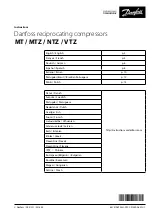
QP Series
Quincy Compressor
2022201802, July 2014
18
3501 Wismann Lane, Quincy Ill. - 62305-3116
to these combinations to ensure that the motor is not over loaded by operating
above or below the designed speed range.
Whatever combination is employed, the drive pulleys & com pressor sheaves
must be properly aligned and drive belt tension set to specifica tions (refer to
SECTION 5, Pulley / Sheave Alignment & Belt Tension
). Improper pul-
ley/sheave alignment and belt ten sion can cause motor overloading, excessive
vibration, and prema ture belt and/or bearing failure.
Excessive compressor RPM’s (speed) could cause a pulley or sheave
to shatter. In an instant, the pulley or sheave could separate into
fragments capable of penetrating the belt guard and causing bodily
harm or death. Do not operate the compressor above the recom-
mended RPM (refer to SECTION 2, Specifications).
Guards
All mechanical action or motion is hazardous in varying degrees and needs
to be guarded. Guards should be designed to achieve the required degree of
protection and still allow full air flow from the compressor sheave across the
unit. Guards shall be in compliance with OSHA safety and health standards
29 CFR 1910.219 in OSHA manual 2206 and any state or local codes.
Guards must be fastened in place before starting the compressor
and never removed before cutting off and locking out the main
power supply.
Check Valves
Check valves are designed to prevent back-flow of air pressure in the com-
pressed air system (air flows freely in one direction only). The check valve must
be properly sized for air flow and tempera ture.
Do not rely upon a check
valve to isolate a compressor from a pressurized tank or compressed
air delivery system during main tenance procedures!
Manual Shutoff Valves
Manual shutoff valves block the flow of air pressure in either direction. This
type of valve can be used to isolate a compressor from a pressurized system,
provided the system is equipped with a pressure relief valve ca pable of being
manually released. The pressure relief valve must be installed between the
manual shutoff valve and the compressor (refer to
Fig. 3-9, Typical Drop
Leg & Component Location
).
Pressure Relief Valves
Pressure relief valves aid in preventing system failures by relieving system
pressure when compressed air reaches a determined level. They are available
in various pressure settings to accommodate a range of applications. Pressure
relief valves are preset by the manufacturer and under no circumstances should
the setting be changed by anyone other than the manufacturer.
Pressure relief valves are designed to protect compressed air
systems in accordance with ASME B19 safety standards. Failure to
provide properly sized pressure relief valves may cause property
damage, severe personal injury or even death.
WARNING !
WARNING !
DANGER !
Summary of Contents for QP Series
Page 2: ......
















































